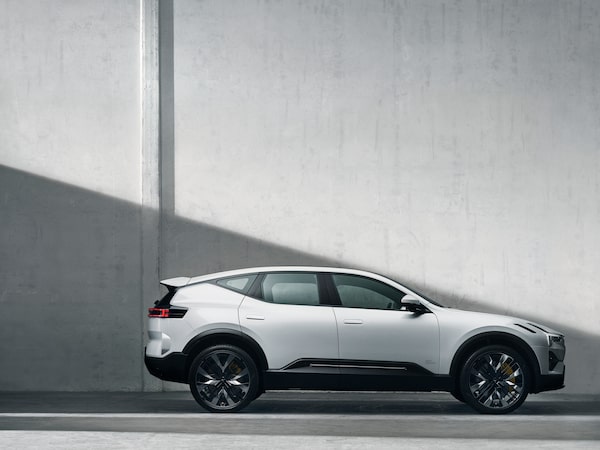
The Polestar 3.Handout
Polestar hasn’t had an easy go in launching its all-new electric car brand. Its sales ramp-up coincided almost exactly with the start of the pandemic, but even in a market where sales are constrained by more than supply and demand, the Swedish auto maker says it still hopes to hit its 2022 sales target of 50,000 vehicles.
If that goal seems low, remember Polestar is a premium brand co-founded by Volvo and Zhejiang Geely, and currently only sells one model, the Polestar 2 sedan.
Just revealed in Denmark, however, is the model that should become Polestar’s breakout vehicle. For one thing, the Polestar 3 is a crossover SUV, a much more popular segment than the sedan. For another, the 3 will eventually be built in the United States (the Polestar 2 is currently built in China.)
That said, if you’re attracted by the Polestar 3′s sharp looks and impressive specifications, you’ll need to be patient. You can order one on Polestar’s website now, but first deliveries are still about a year away. And U.S. production doesn’t start until mid-2024; initial production will be in Chengdu, China.
If you’re on a budget, you may have to wait even longer. As it did with the 2, Polestar is launching the 3 in near-fully-loaded form – long-range dual-motor with the mandatory Pilot Pack (a bundle of assisted-drive features) and Plus Pack (Bowers & Wilkins audio, plus sundry luxury and cosmetic add-ons). Thus equipped, the starting price is $97,400 before freight and taxes. Based on 2 pricing, we estimate that a single-motor base-model 3 – if and when it becomes available – would start at about $15,000 less.
For that money, you’ll be getting a mid-size two-row crossover similar in length to a BMW X5 or Mercedes GLE. Its overall height is significantly lower than typical alternatives – with a lower, more car-like driving position to match – yet nominal ground clearance of 211 millimetres is class competitive. We say “nominal” because the launch version will have air suspension that can be raised for off-road clearance, or lowered for highway cruising. Adaptive damping will also be standard.
Polestar steered clear of third-row seating, in part to ensure a spacious and comfortably reclined second row, but also to avoid conflict with its three-row Volvo XC90 cousin.
The lack of a third row also opens up design possibilities. Recognizing that SUVs aren’t always viewed as socially benign, Polestar chief executive officer Thomas Ingenlath said the Polestar 3 was designed to avoid “looking like it eats kids for breakfast.” The new car will also help to define the brand’s design language in the future, design chief Maximilian Missoni said.
Among its more striking details are aerodynamic wings in the leading edge of the nose and in the rear spoiler. The drag coefficient of 0.29 is low for an SUV, and aerodynamics benefit further from the relatively low front area. Then again, the Polestar 3 is no lightweight at more than 2,500 kilograms.
Polestar’s commitment to sustainability goes beyond the electric propulsion itself. It has set a goal of carbon-neutral manufacturing by 2030. Among other measures, that includes pursuing the three Rs in battery manufacturing and a commitment to ensure ethical sourcing of raw materials.
Wool is fully traceable, sustainability chief Fredrika Klaren said Polestar uses blockchain technology to trace the cobalt used in the batteries.
As introduced on the Polestar 2, the 3′s in-vehicle operating system is Android-based, co-developed with Google. The car’s AI brain is a centralized Nvidia core computer that processes data from five radar modules, five external cameras and 12 external ultrasonic sensors to support a comprehensive suite of advanced driver-assistance systems (ADAS). Next year, customers will be able to order a Lidar package with additional cameras and sensors to help prepare the vehicle for autonomous driving.
It’ll be a while before we can drive the Polestar 3, but we were able to clamber in and out of a parked prototype at the reveal event. The rear seat is luxuriously reclined and legroom is ample, though foot room is tight behind the driver if their seat is set low. A floating, 14.5-inch vertical screen dominates the cockpit, while the “gauge cluster” takes the form of a small, shallow screen (similar to a Ford Mustang Mach-E) that’s attached to, and adjusts with, the steering column. Also column-mounted, on a stalk, is the drive selector.

The gauge cluster on the Polestar 3 is a small, shallow screen that’s attached to, and adjusts with, the steering column.Handout
The dual electric motors (one on each axle) produce a combined 489 horsepower and 620 lb-ft of torque, rising to 517 and 671 with the Performance Pack option. The rear motor is more powerful and includes torque vectoring to promote a rear-wheel-drive feel when appropriate.
The 400-volt battery has a capacity of 111 kilowatt hours and can handle DC fast charging up to 250 kilowatts, or Level 2 charging at 11 kilowatts. Predicted range on a full charge is 480 kilometres and the 10-to-80-per-cent fast-charge benchmark takes 30 minutes.
A mechanical heat pump is standard and the vehicle is also equipped for bidirectional charging, for example, to enable future vehicle-to-grid or home-backup capability.
Polestar is currently sold in 25 markets worldwide, and in Canada there are three sales points – Vancouver, Toronto and Montreal. According to publicist John Paolo Canton, the Montreal store alone is selling so many Polestars that, if it were a country, Montreal’s sales would be the sixth-highest on the planet.
The writer was a guest of the auto maker. Content was not subject to approval.
Shopping for a new car? Check out the Globe Drive Build and Price Tool to see the latest discounts, rebates and rates on new cars, trucks and SUVs. Click here to get your price.